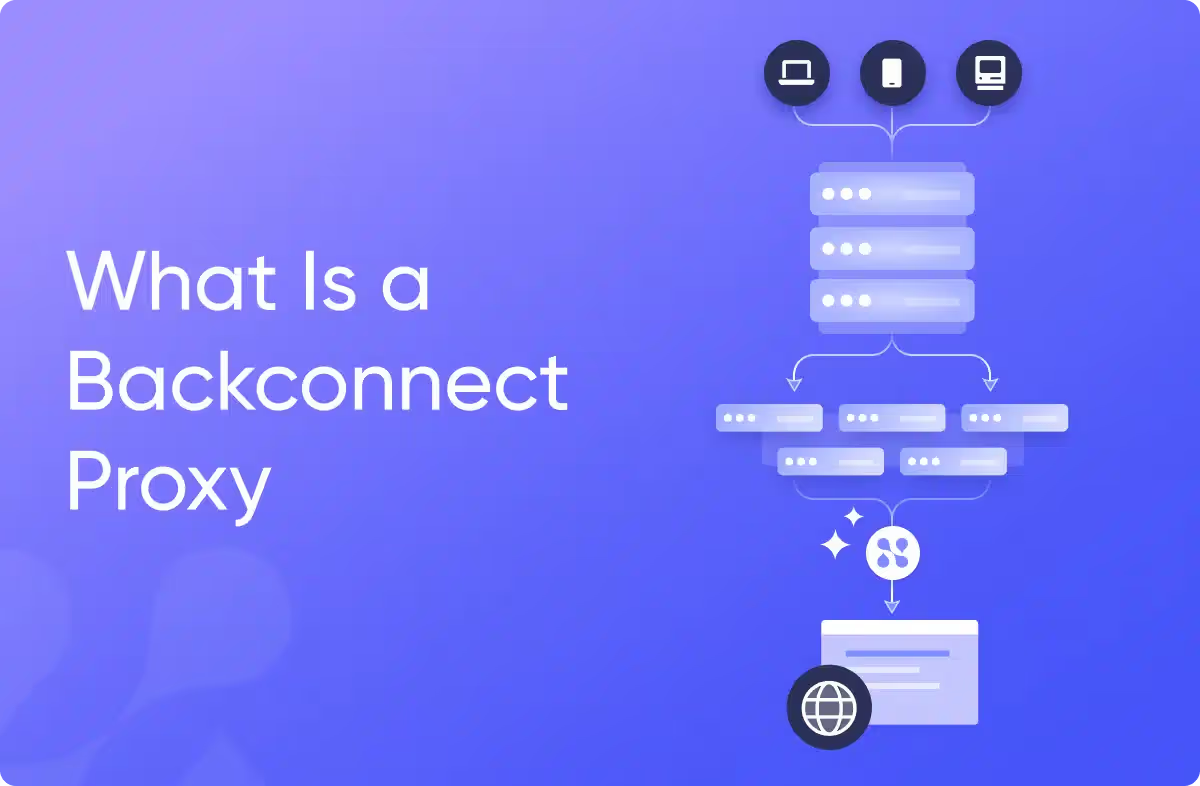How to Use cURL with a Proxy: The Ultimate Guide
Learn how to use cURL with a proxy and why you should use them together.


Using cURL with a proxy? This guide is here to help! We’ll go over everything from how to install cURL to how to use it with different types of proxies. It’s all laid out in easy-to-follow steps, so whether you’re new to this or just need a refresher, we’ve got what you need.
Key Takeaways: 4 Steps to Using cURL with a Proxy
- Step 1: Find the required proxy details like IP address, port number, username & password, and proxy type.
- Step 2: Connect your proxy by using the command-line interface to run a command with the above information.
- Step 3: Handle any authentication requirements.
- Step 4: Execute advanced proxy configurations if necessary, like custom headers, proxy type, tunneling, or using different proxies for different protocols.
The Basics: What Are cURLs and Proxies, and Why Should You Use Them Together?
Before we dive into how you can configure a proxy to run with a cURL, let’s cover the basics of what exactly these tools are and when you should use them.
What Is cURL?
Explain Like I’m 5:
cURL is the technology that allows people to transfer data using URLs. It dates back to the late 90’s and is foundational to countless technologies, including most software, mobile phones, games, and media players.
Explain Like I’m 35:
cURL (or client for URL), is an open-source command-line tool for transferring data between your device and a server using a URL. cURL supports every major network protocol, including HTTP, HTTPS, GOPHER, and FTP, and is operated via a command-line interface (or CLI). Using the CLI, you can enter a server URL and the data you want to send to that URL, and cURL takes care of the rest.
The term “cURL” is also sometimes used to refer to the libcurl development library, which is part of the same software project that is responsible for the cURL command.
To learn more about cURL, you can access the project’s website here.
What Is cURL Used For?
cURL is used in countless technologies and applications, including mobile phones, printers, software, and anything where transferring data via URLs is necessary. You likely used a technology that utilizes cURL today.
For developers, cURL is often used to:
- Make HTTP requests to interact with APIs, test endpoints, or retrieve web data.
- Download files from remote servers and fetch resources programmatically.
- Automate scripts to perform data transfers or API requests.
- Test and debug APIs by sending requests directly from the terminal, which makes it easy to inspect responses and troubleshoot issues.
- Send data via HTTP headers, POST forms, or file uploads to submit form data, upload files to a server, or post JSON payloads to APIs.
- Store, send, and handle cookies to simulate browser behavior, test cookies, or to help automate interaction.
- Authenticate users to access secure APIs.
What Are Proxies?
A proxy, or proxy server, acts as a gateway between your computer and the internet. It’s a server that “sits” between you and the websites you visit, handling your requests on your behalf.
You can think of a proxy server as a middleman in a conversation. You tell the middleman what you want to say, and he passes the message along to the other person, without revealing that you were the original source of the message.
There are different types of proxies, including residential proxies, data center proxies, ISP proxies, rotating proxies, and more.
What Are Proxies Used For?
Proxies are generally used in situations where it’s beneficial to hide your IP address or to make it look like your traffic is coming from a different location (or, many different locations). They provide many benefits, including anonymity, security, content control, geotargeting abilities, and the ability to bypass many security and anti-scraping measures.
Developers typically use proxies to:
- Scrape data from websites, often at high volumes, while avoiding IP bans, rate limiting, and other anti-scraping restrictions.
- Bypass geo-restrictions so they can access content or services that aren’t available to their normal IP address.
- Test and QA how applications or websites behave in different regions or under various network conditions.
- Balance loads by distributing traffic across multiple servers.
- Manage multiple accounts on a single platform without triggering bans or blocks.
- Enhance privacy and anonymity during testing, research, and many other activities.
- Run bots and automations without triggering IP blocks, rate limits, and other restrictions.
Why Use cURLs with a Proxy?
By using premium proxy services with cURL, you can perform many of the tasks you would normally use cURL for, but with the added bonus of:
- Enhanced privacy and security.
- The ability to route your traffic through different IP addresses across the globe.
- Enhanced ability to bypass IP bans, rate limits, and other restrictions.
- Allowing you to scale the amount of requests you’re sending by routing it through different IP addresses.
This makes proxies useful for bypassing geographical restrictions that might limit access to specific content and streamlining browsing by avoiding blocks and bans from target websites. cURLs with proxies are particularly powerful for tasks like web scraping, where gathering data without detection or blocking is crucial. Proxies can also be vital for testing websites from different locations, simulating how users from various parts of the world experience a website.
In essence, using cURL with proxies adds an extra layer of versatility and security, opening up new possibilities and giving you more control over your online interactions. Whether you’re a developer, a researcher, or just someone looking to explore the web more freely, proxies add a new dimension of safety, anonymity, and efficiency to your online experience.
Tutorial: Using cURL With Proxies
In this section, we’ll guide you through how to set up cURL with a proxy. We’ll cover how to install cURL, tool commands you can use with cURL, and how to connect and use cURL with different popular types of proxies.

Getting Started With cURL: Installation Across Different Operating Systems
Here is how you can easily install cURL on different operation systems. For more detailed information and steps for installation, check out the cURL docs or the cURL website.
Windows
You can download a cURL executable from the official guide on the cURL website and follow the instructions. Sometimes, cURL might already be included in your system. Go here for more information.
Mac
Luckily, Mac users with a modern version of MacOS usually have cURL pre-installed. Open the Terminal and type curl --version to check if it’s installed. If it’s not, you can use a package manager like Homebrew to install curl. Follow these instructions to proceed.
Linux
Depending on your Linux distribution, you might use commands like sudo apt-get install curl or sudo yum install curl to install curl. It’s often pre-installed in many distributions. For more information, follow these instructions.
Basic cURL Commands
Once you’ve got cURL installed, here’s how you can start using it:
- Fetch a Webpage: Simply use ‘
curl http://www.example.com’ to get the HTML content of a webpage. - Download a File: Need to grab a file? Use ‘
curl -O http://www.example.com/file.zip’ to download it to your computer. - Send data: You can even use cURL to send data with POST requests. For example, ‘
curl -d "username=user&password=pass" http://www.example.com/login’ will send login information. - Use Headers: If you need to add headers to your request, just include them with the
-Hoption, like this: ‘curl -H "Authorization: Bearer YOUR-TOKEN" http://www.example.com/api’. - Save an Output: Want to save the result of a cURL command to a file? Use ‘
curl http://www.example.com -o output.html’.
These are just the basics, but they’ll get you started. cURL has many more features which we are going to discuss soon and options that you can explore as you get more comfortable with it.
Connecting to a Proxy With cURL
Connecting to a proxy with cURL doesn’t have to be complicated. It’s about using the right information and commands. Let’s delve into how to do this, step by step.
Necessary Proxy Details to Connect cURL with Proxies
Before you can connect to a proxy with cURL, you’ll need to choose a reputable proxy provider. Then, you’ll need the following details:
- IP Address: The unique address of the proxy server.
- Port Number: The specific port used by the proxy server.
- Username and Password: If authentication is required.
- Proxy Type: Usually HTTP/HTTPS or SOCKS.
Once you’ve got all the details needed, you’ll proceed to run a cURL command with a proxy.
Using cURL with a HTTP/HTTPS Proxy
To connect to an HTTP or HTTPS proxy, you’ll need to open a command-line interface like Command Prompt on Windows or Terminal on MacOS/Linux. Once you have it open, you can run the following command:
curl -x http://username:password@proxy_ip:proxy_port http://example.com
Replace username, password, proxy_ip, and proxy_port with your specific details.
Using cURL With a SOCKS Proxy
Connecting to a SOCKS proxy is a similar process. Open your command-line interface and enter the following code:
curl --socks5 username:password@proxy_ip:proxy_port http://example.com
Again, make sure to replace the placeholders with your information. This command will route your request through the SOCKS proxy to the desired website.
Handling Authentication When Using cURL With Proxies
When connecting through a proxy, you may often need to authenticate your connection with a username and password. With cURL, this can be handled smoothly.
- Basic Authentication: To use basic authentication with a proxy, you can use the following command in your command-line interface:
curl -U username:password -x http://proxy_ip:proxy_port
http://example.com
- Digest Authentication: If the server requires digest authentication, you can use the ‘
--proxy-digest’ option:
curl --proxy-digest -U username:password -x http://proxy_ip:proxy_port http://example.com
- NTLM Authentication: For Windows-based authentication (NTLM), the command would be:
curl --proxy-ntlm -U username:password -x http://proxy_ip:proxy_port http://example.com
These commands ensure a secure connection while maintaining the ease of use that cURL is known for.
Advanced Proxy Configuration With cURL
Sometimes, advanced configurations are necessary when using cURL with proxies, especially for more complex tasks. Advanced configurations allow for more precise control over how cURL interacts with proxies, and can enable better efficiency and flexibility when dealing with scripts, automation, or specific security requirements.
Here are some popular advanced configurations and how to enable them.
Command-Line Arguments for Proxy Settings
The power of cURL comes from its flexibility in using different command-line arguments for managing proxy settings. This provides granular control over connections. Let’s take a look at some interesting examples:
- Custom Headers: Add specific headers with '
--proxy-header'. This can be useful for various authentication schemes:curl --proxy http://proxy_ip:proxy_port --proxy-header "Header-Name: value" http://example.com - Proxy Type: Specify the type of the proxy with ‘
--proxy-type’. This can be HTTP, HTTPS, SOCKS4, etc.:curl --proxy-type HTTPS --proxy http://proxy_ip:proxy_port http://example.com - Ignoring Proxy for Specific Domains: Use ‘
--noproxy’ to ignore the proxy for specific domains or subdomains:curl --proxy http://proxy_ip:proxy_port --noproxy "example.com, subdomain.example.com" http://another-example.com - Tunneling Through Proxy: Utilize ‘--proxytunnel’ to tunnel a connection through an HTTP proxy:
curl --proxytunnel --proxy http://proxy_ip:proxy_porthttp://example.com - Using Different Proxy for Different Protocols: You can specify different proxies for different protocols like HTTP, HTTPS, etc.:
curl --proxy http://http_proxy:port --proxy http://https_proxy:port http://example.com
Wondering what the difference is between tunneling and simply stating that the proxy type is HTTP?
In summary, --proxytunnel ensures a continuous connection between the client and destination, while --proxy-type HTTP without tunneling makes the proxy directly involved in the request and response process. The choice between them depends on the specific requirements and security considerations of your connection.
Using Environment Variables
You can set proxy settings as environment variables, making them reusable across multiple cURL commands. For example, in Unix/Linux, you can use:
export http_proxy=http://username:password@proxy_ip:proxy_port
curl http://example.com
This allows for a centralized configuration, which can be especially useful in scripts or automated processes.
Configuring cURL to Always Use a Proxy
To make cURL always use a specific proxy, you can place the appropriate settings in a ‘.curlrc’ file. For instance, in your home directory, you might include:
proxy = http://username:password@proxy_ip:proxy_port
Every cURL request will now pass through this proxy unless explicitly overridden.
Ignoring or Overriding a Proxy for Specific Requests
Sometimes, you may want to bypass using a proxy for certain requests. For example, if you’re working within a corporate network and the proxy is primarily used to handle external traffic, you might want to bypass the proxy for internal requests.
You can use the ‘--noproxy’ option for this:
curl --noproxy example.com http://example.com
Or, you can override the global proxy settings by specifying a different proxy for a specific request using the ‘-x’ option.
Expert Tips, Tricks, and Troubleshooting for Using cURL With Proxies
Here are a few bonus tips to make using cURL with proxies easier, more streamlined, and hassle-free.
How to Quickly Switch Proxies
Switching proxies “on the fly” can be essential for various tasks, such as web scraping or bypassing rate limits.
Utilize bash functions or scripts that modify your cURL commands to include different proxy details. You can also use aliasing in your shell to create commands for specific proxies.
Troubleshooting: Common Errors for Using cURL With Proxies
Facing a proxy error code when using cURL with a proxy? Here are the most common issues and how to solve them:
- 401 Unauthorized: Check your username and password.
- 407 Proxy Authentication Required: Ensure that your proxy credentials are correct.
- Connection Timed Out: Verify the proxy IP and port. The server might be down.
Using cURL with a Proxy in Different Programming Languages
Leveraging cURL with proxies is not limited to the command line. Various programming languages offer libraries and tools to work with cURL, improving your flexibility and automation options, whether you’re web scraping, connecting to APIs, or doing other online tasks.
Here’s a closer look at Python and PHP:
Python
Using cURL with proxies in Python is often done through the pycurl library. It’s an effective way to handle web scraping with Python, as it enables seamless integration of proxy settings into your requests. This makes it a powerful tool for data extraction and manipulation.
PHP
In PHP, you can use the cURL extension to perform similar tasks. The extension allows you to set up proxy configurations within your HTTP requests, making it easier to connect to various services securely and efficiently.
Best Security Practices for Using cURL With Proxies
When working with proxies, especially if handling sensitive data, security should be a top priority. Here are some best practices:
- Use HTTPS Proxies: Always encrypt your connection.
- Avoid Public/Free Proxies: They may log or modify your requests.
- Regularly Update cURL: Stay updated to prevent vulnerabilities.
- Use Verified Proxy Services: Known and trusted services like Nimble provide a secure environment.
How to Use cURL with Proxies: Real-World Use Cases
Wondering how you can apply this knowledge to the real world? Here are two use cases that demonstrate the versatility and impact of using cURL with proxies.
Web Scraping with cURL and Proxies
Web scraping has become a widely used method for extracting information from websites, and using cURL with proxies plays a crucial role in this process.
By using cURL and residential proxies, it’s possible to send requests that mimic real user behavior, thereby avoiding detection by anti-scraping measures. You can also avoid rate limits and send a high volume of requests. This enables businesses to gather valuable data from competitors, monitor pricing, and analyze customer sentiment.
Here’s a few examples of how companies may use cURL with a proxy for web scraping:
- Competitive Analysis: Gather data on competitors’ prices, products, and promotions to adjust strategies.
- Market Research: Collect data from various sources to understand market trends and customer preferences.
- Content Aggregation: Building a content repository by scraping news sites, blogs, and other content-rich platforms.
Monitoring Website Performance
Monitoring website performance is vital for maintaining optimal user experience and search engine rankings. By employing cURL with proxies, businesses can simulate user interactions from different locations, devices, and networks to test the site’s loading time, responsiveness, and overall functionality.
For example, an online retailer might use cURL to test how quickly product pages load from various geographical locations. If a page takes too long to load, adjustments can be made to the site’s code or hosting configurations to improve performance.
This approach helps in identifying and rectifying performance issues, ensuring that users always have a smooth and enjoyable experience on the site. It’s a practical application of cURL and proxies that has direct implications for a website’s success and credibility.
Conclusion: Take Your Web Scraping to The Next Level with Nimble
The use of cURL with proxies opens endless possibilities for data collection and web interaction. If you’re looking for the perfect proxy to pair with cURL, consider Nimble’s rotating residential proxies. The come with advanced AI fingerprinting and proxy rotation that can help you bypass restrictions on even the most hard-to-scrape website.
Or, if you’re looking to take your web scraping to the next level and cURL doesn’t feel like the perfect solution, try Nimble’s advanced web scraping API.
FAQ
Answers to frequently asked questions

.avif)












